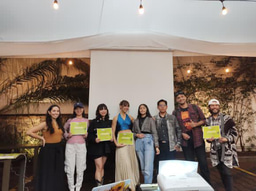Reflection on the LiA Programme
The six-week journey of Leadership-in-Action Programme has been inspiring, innovative, and appreciative. We learned the strategies of design thinking and applied leadership skills into action by initiating and conducting a social project in a local organization.
The best part about the programme is that it provides the opportunity and resources for us to live, learn, and grow in a community. Living together, having training sessions together, sharing inspirational mornings, doing projects in a team, and exploring the city, all these experiences have shaped the way we think, work, and live. Through the process, we learn to appreciate diversity, take responsibility for various roles, and bring out the best in everyone. Through creating an impact through design thinking methods, I learned how to truly embrace the idea of community, where everyone can support and learn from each other to achieve organic growth and regenerative impacts.
For my Leadership-in-Action Project on climate change in Mexico City, I collaborated with a team of four scholars and a local organization, Huerto Roma Verde. We received design thinking training from MakeSense and applied the five stages—empathizing, defining, ideating, prototyping, and testing—to our project. This practical application of design thinking equipped me with problem-solving strategies I now use in various aspects of my life and work.
The project in Huerto Roma Verde is focused on user experience design. As a scholar team, we co-created the user experience for tours to showcase Huerto Roma as a hub of urban resilience, helping the organization produce translated communication materials and promoting sustainable tourism and local participation around this space. This involved assisting the organization in developing translated communication materials, promoting sustainable tourism, fostering local engagement in the area, and gaining insights from the experience to understand how the local organization successfully made a positive impact on the community. To achieve the goals, we took concrete actions and produced measurable deliverables through the six weeks. We developed a digital self-guidance leaflet in English and Spanish for visitors to Huerto Roma Verde, finalized a tour script in both languages for free guided tours showcasing the history, sustainable practices, community engagement, artistic elements, and philosophical concepts of the space as a reflection of the local community's environmental conservation efforts and connection to nature. We created a series of cartoon mascots inspired by the Mexican axolotl to symbolize the organization. We also designed and refined informational boards featuring descriptions and mascots to emphasize key points of interest and offer guidance.
Furthermore, we gained a deeper insight into how local social initiatives contribute to the fight against climate change. Through the actions, we practiced and learned how to carry out user surveys, user persona characterization, customer journey mapping, graphic design, information writing and editing, script writing, woodwork, focused group interviews, and materials purchasing. Working in Huerto Roma Verde inspired me to see how arts and technology can be combined in design and daily life functions to change people’s daily lives, reconnect them to their traditional culture and nature space, and thus impact the community to save the environment.
Additionally, I learned and enhanced my communication and collaboration skills through teamwork and the engagement of volunteers. Working in a team on multiple tasks required us to make clear and realistic timelines, set measurable and achievable goals, communicate efficiently and accurately with teammates, be productive, and take responsibility. It was a process of learning project management and teamwork. We also received training on engaging volunteers, and more than ten volunteers from Mexico contributed significantly to the project. The language barrier was one of the challenges. Still, we overcame it by creating graphics and visual information, making slides in both English and Spanish, efficiently managing the WhatsApp group by organizing the materials and putting the links in the group, giving out surveys to collect everyone’s availability and talents, and so on. We engaged the volunteers in editing the scripts, selecting mascots, and producing info boards, which can bring out the best in people’s talents. We also built up friendships with some volunteers, enabling more cultural exchanges. I was sincerely grateful for the chance to be immersed in the cultural experience, learn from the local community, and try to make an impact.
This programme is educational, inspirational, and practical. It proved how individuals and communities can pull together and generate positive impacts on the eco-social environment. It was also a great and enjoyable experience to improve design thinking and teamwork skills. I am sincerely grateful for this precious opportunity and all the people who have supported and helped us. We learned a lot from the journey and also from each other. I can not wait to carry the memory and the experience further into the future.



Please sign in
If you are a registered user on Laidlaw Scholars Network, please sign in